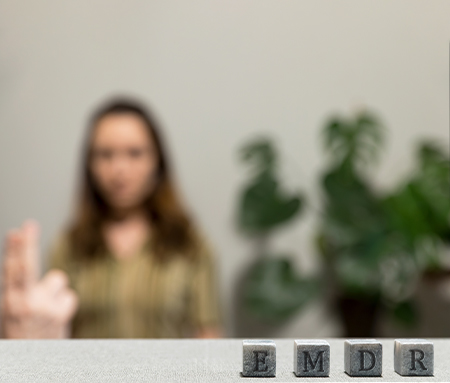 If you’re looking for effective relief from trauma…
If you’re looking for effective relief from trauma…
You’ve found it!
Eye Movement Desensitization and Reprocessing (EMDR) is an extensively researched, evidence-based therapy that has been shown to alleviate the effects of single-trauma and multiple-trauma events.
EMDR was originally created to address PTSD, but it’s since been proven an effective treatment for generalized anxiety, panic attacks, phobias, and social anxiety.
EMDR reduces the effects of triggers and instills positive beliefs about yourself in areas where you feel capable but inadequate.
It’s very different from traditional talk therapy.
It has a specified sequence of events that take place in eight phases. These phases may not occur sequentially, and some may need to occur more than once.
We call the source of your pain or anxiety a “target.” EMDR “clears” these targets. It’s not uncommon to identify more targets while addressing another.
It’s a process… and it’s all part of your journey toward healing.
 These are the eight phases…
These are the eight phases…
Phase 1 – History Taking
In this phase, we’ll determine the best place to begin – the possible “targets” to address through EMDR. These targets are the memories or situations, past or present, causing you emotional distress.
Phase 2 – Skills for Handling Emotional Distress
During the second phase, we’ll give you the foundation and skills needed for future EMDR phases. These skills will keep you grounded and help you regulate any heightened emotions you might experience during session.
Phase 3 – Negative and Positive Cognitions
In this phase, we’ll look at the specific targets that led to your current difficulties and your negative beliefs about yourself because of them. We’ll then identify what you would rather believe. An example of a negative cognition might be “I’m inadequate,” and a positive cognition you would prefer to believe about yourself might be “I am enough.”
Phase 4 – Reducing Disturbance of the Memories Related to an Incident
Here, we’ll reprocess the identified target to reduce the disturbance level of your memories about it. This is measured on a scale of 0 – 10, where 0 is no disturbance, and 10 is the highest possible.
During this phase, other memories or feelings that seem unrelated might come to light. This is part of the process. Often, a single event, or the recurrence of a negative event over and over, can stir up feelings and emotions about a different event that created the same feeling or emotion.
Working through these targets with EMDR creates pathways for new connections and positive beliefs in the brain.
 Phase 5 – Instilling Positive Cognitions
Phase 5 – Instilling Positive Cognitions
Once the distress level of the target is 0, we move to Phase 5. In this phase, we instill the desired positive cognition (“I am enough” from the example above) onto the target. We work on this phase until this desired belief feels totally true on a scale of 1 to 7, where 1 is totally false, and 7 is totally true.
Phase 6 – Body Scan
During phase 6, we complete a body scan. We’ll start at your head and move down to your feet, noticing what you are experiencing in your body. If the sensations are positive, we reinforce them. If negative, we reprocess them until the discomfort goes away.
Phase 7 – Closing the Session
If at the end of the session you are experiencing a 0 level of distress and a 7 level of positive belief, we will discuss keeping a log of things (thoughts, emotions, actions) that appear throughout the week since processing the target. In the next session, we will discuss whether those things need to become targets and reprocess them or if something else needs to be addressed.
But if you continue to have any distress or negative beliefs, we’ll do some grounding work or a containment exercise to reduce those levels.
Phase 8 – Beginning the Next Session
In the next session, we will begin by discussing the progress made in the previous session(s) and what you have experienced since the last session.
You’ve suffered with this long enough.
If you are sick and tired of being stuck in the past, reliving painful memories, or experiencing anxiety at every turn, this is your path to healing.
For more information on EMDR, how it works, and why it may be beneficial for you, I recommend the EMDR International Association’s (EMDRIA) introductory video.
EMDR is safe and effective, and it can give you results much more quickly than traditional talk therapy.
So, let’s get started! Take the first step toward healing and a peaceful life. Call now for your free consultation: (479) 222-0688.

